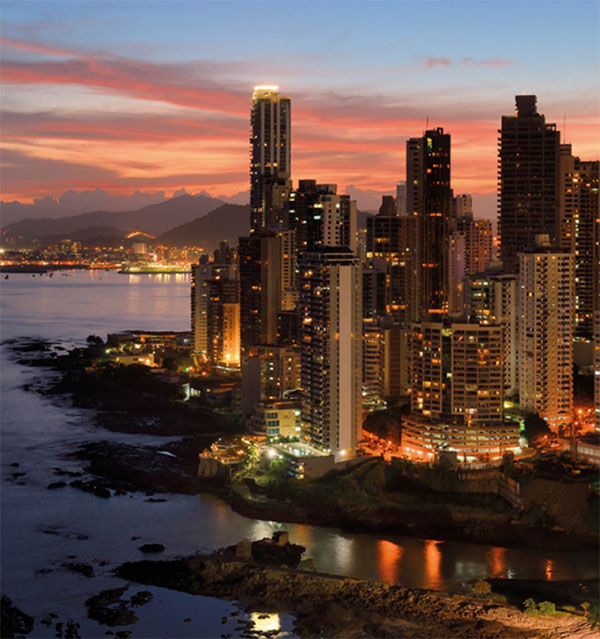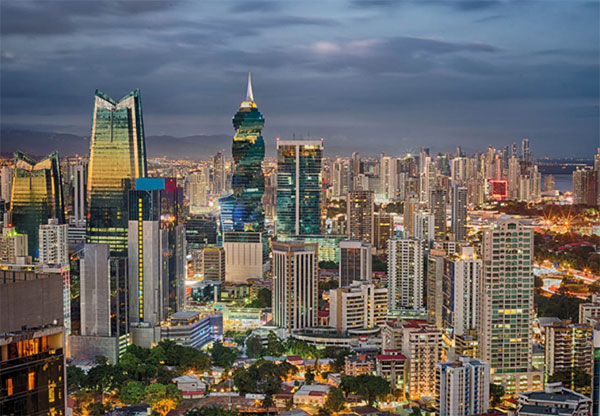PANAMA
The isthmus of Panama is where Central America comes to its wild conclusion, from a modern metropolis to untouched rainforests and endless beaches.
Main Attractions
Panama City
The Panama Canal
Portobelo
Azuero Peninsula
Boquete
Bocas del Toro
Comarca Kuna Yala
The Darién
No country in Central America has entered the 21st century quite as boldly as Panama. The zigzagging economy, still anchored by the canal, which fell under Panama’s complete control on the last day of 1999, is being pushed along by its status as a tax haven, some of it on the shady side, as the Panama Papers revealed in 2016.

Punta Paitillia’s skyscrapers, Panama City.
Getty Images
In Panama City, the skyline has gone from a few skyscrapers to hundreds. The region’s first metro has been installed here and glitzy malls and restaurants are as cosmopolitan as anything in New York or Paris. At first glance, you might mistake the city for Dubai or Hong Kong, but the rainbow-colored buses blasting reggaeton assure you that this metropolis is Latino without a doubt.
Tourism here is quickly catching up to Costa Rica, though thus far there’s no threat to authenticity or to the rich flora and fauna. The canal is bigger than it once was and sees more cruise traffic than ever before, but much of the country remains free from crowds. Coffee farms around Boquete and hiking trails along the canal zone attract the same birders and java geeks as they always have, while Afro-Caribbean towns like Portobelo and fishing lodges in the Gulf of Chiriquí have remained decidedly low-key. Still, wherever you go, the amenities have gotten better, and a bit nicer. While the Pan-American Highway remains the most popular way to travel from the capital in the east to David in the west, low-cost airlines have cut travel time to remote destinations like Bocas del Toro and the Azuero peninsula, where new beach hotels and eco-chic resorts are opening by the handful.
Culturally, the country of 4 million is also rich. In remote mountain ranges and tropical isles, Indigenous groups like the Emberá and Kuna carry on their traditions. Elsewhere, the country’s genetic make-up has been altered by waves of immigrants, from the Spanish conquistadors to the Jamaicans and Italians and Americans that came for the canal to the recent surge of retirees and Venezuelans seeking better opportunities.

Panamax container ship in the canal.
Getty Images

A new era begins
A new era in Panama began on December 31, 1999, when the US formally transitioned all operations of the Panama Canal to Panama, as well as turned over all military bases. The act was more than 20 years in the making, beginning in 1977 when US President Jimmy Carter signed the Torrijos-Carter Treaty that gave Panama increasing control of the canal until the date of a complete US withdrawal.
While there were fears that the Panamanians would not be able to maintain operations and security on the strategic waterway, the Panama Canal Authority (ACP) have eased all concerns. From the first year under Panamanian control to 2016, income increased from $769 million to $2.6 billion. Accidents have dropped, traffic has increased, and expenses have increased less than revenue. In 2016, the canal completed a $5.25 billion expansion that took 10 years to build, giving it the ability to accommodate many of the world’s largest cargo vessels (for more information, click here).
The return of corruption
In 2004, the Democratic Revolutionary Party’s Martin Torrijos won the presidency, campaigning on promises of ending corruption. Torrijos immediately went to work passing laws that made the government more transparent, though there was little follow through when high profile cases appeared.
Succeeding Torrijos was Conservative supermarket magnate Ricardo Martinelli, who won a landslide 60 percent of the vote in 2009. Voters had feared that the world financial crisis was already slowing Panama’s rapid growth rate of previous years and Martinell’s business experience could come in handy. His pro-business policies helped the annual GDP to increase by more than 10 percent each year, turning Panama into one of Latin America’s fastest growing economies, projected to be the fastest-growing in 2017. However, Martinelli proved to be far from perfect. Many in his administration, including his sons, have been investigated or charged with accepting millions in bribes from Brazilian construction firm Odebrecht S.A., which became an important government contractor during that time.

Panama City has a thriving financial center.
iStock
Fact
During the 19th century California Gold Rush, thousands of forty-niners crossed the isthmus of Panama as a shortcut from the East Coast of the US to California, rather than sailing around Cape Horn at the southern tip of South America.
Martinelli was followed by his former political partner Juan Carlos Varela in 2014, amidst a sudden dip in the economy. Not long after being sworn in, the Panama Papers scandal broke. The vast data leak from the Mossack Fonseca law firm detailed how the world’s wealthy stashed assets in offshore companies. While the Varela administration claimed to be strengthening controls over money laundering in Panama and appointed an independent investigation, they have refused to make the final reports to be public.
Panama City and around
Founded in 1519 by Pedro Arias Dávila, Panama City 1 [map] is the oldest Spanish settlement on the mainland of the Americas. The original settlement was where gold and silver being raided from South America was unloaded at sea and then transported over the isthmus by road to the Caribbean, attracting the attention of treasure-hungry pirates. By 1673 the settlement had been destroyed by attacks and then rebuilt in in present day Casco Viejo, which became heavily fortified, ensuring the city could withstand any further attacks. It lingered in obscurity until Panama seceded from Colombia and was designated the capital in 1903. When the canal was built in 1914, it became the center of trade and commerce in the Americas.